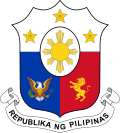| ||||||||||||||||||||||
All 90 seats in the House of Representatives of the Philippines 46 seats needed for a majority | ||||||||||||||||||||||
|---|---|---|---|---|---|---|---|---|---|---|---|---|---|---|---|---|---|---|---|---|---|---|
| ||||||||||||||||||||||
| ||||||||||||||||||||||
 |
|---|
Elections for the members of the House of Representatives were held on June 3, 1919 pursuant to the Philippine Organic Act of 1902, which prescribed elections for every three years. The ruling Nacionalista Party increased its majority from 75 seats out of 90 seats in the 1916 election to 83 out of 90 seats in this election. The elected representatives would serve in the 5th Philippine Legislature from 1919 to 1922.

